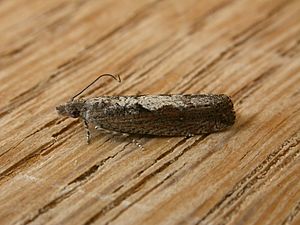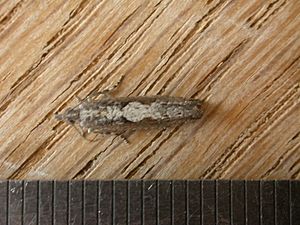Eucalyptus leafroller facts for kids
Stictea macropetana, also known as the eucalyptus leafroller, is a type of moth belonging to the family Tortricidae. This moth is originally from Australia. However, it has also been found in New Zealand since 1921, where it is considered an introduced species.
Quick facts for kids Eucalyptus leafroller |
|
|---|---|
 |
|
 |
|
| Scientific classification | |
| Kingdom: | |
| Phylum: | |
| Class: | |
| Order: | |
| Family: | |
| Genus: |
Stictea
|
| Species: |
S. macropetana
|
| Binomial name | |
| Stictea macropetana (Meyrick, 1881)
|
|
| Synonyms | |
|
|
Contents
Meet the Eucalyptus Leafroller Moth
What Does It Look Like?
The eucalyptus leafroller moth has a wingspan of about 13 to 19 millimeters. This means its wings stretch out about half an inch to three-quarters of an inch wide.
Male moths have front wings that are a plain ash-grey color, often with darker stripes. Female moths have a light, wavy stripe along the back edge of their front wings. This stripe is usually outlined by a thin dark line. Both male and female moths have hindwings that are a brownish-grey color. These hindwings also have a fringe of tiny hairs along their edges.
Life Cycle of the Eucalyptus Leafroller
Hungry Larvae and Their Homes
The young moths, called larvae, love to eat. They feed on the leaves, buds, and even the developing flowers of young eucalyptus trees. Some of their favorite eucalyptus trees include Eucalyptus microcorys, Eucalyptus nitens, Eucalyptus fastigata, Eucalyptus saligna, Eucalyptus cladocalyx, Eucalyptus baxteri, Eucalyptus muelleriana, Eucalyptus obliqua, Eucalyptus globoidea, and Eucalyptus regnans.
These larvae are clever builders! They create a safe home for themselves by using silken threads to pull together leaves and other plant parts. From inside this protective shelter, they can safely munch on their food. A single larva might even build several of these shelters during its lifetime.
When they are very young, the larvae scrape the surface of the leaves as they eat. They might also dig into the tips of new buds. If they keep feeding and spinning their webs, the affected parts of the plant can turn brown. Eventually, the leaves might become just a skeleton of veins and then die.
Growing Up: From Larva to Pupa
When they first hatch, the young larvae are a see-through green or yellow color. As they grow bigger, they become dark green. A full-grown larva is usually about 8 to 14 millimeters long.
After they have eaten enough and grown to their full size, the larvae enter the next stage of their life cycle: pupation. During pupation, the larva changes into a pupa. This change happens inside a silk cocoon. The cocoon can be found in different places, like an old rolled-up leaf, under loose bark, inside a dry leaf, or even in the soil at the base of a tree. From this cocoon, a new adult moth will eventually emerge.

